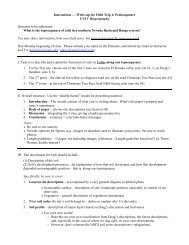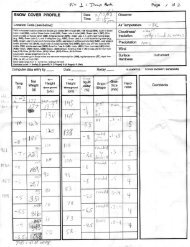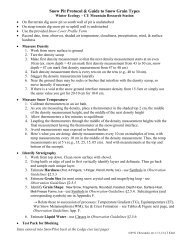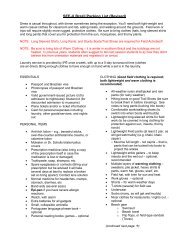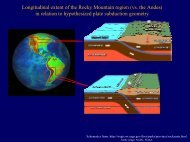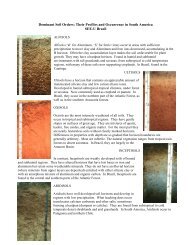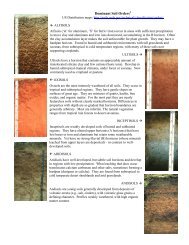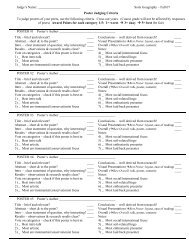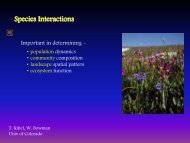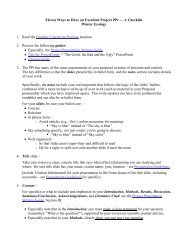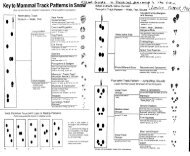Ecological niche modeling
Ecological niche modeling
Ecological niche modeling
Create successful ePaper yourself
Turn your PDF publications into a flip-book with our unique Google optimized e-Paper software.
<strong>Ecological</strong> <strong>niche</strong> and ecological <strong>niche</strong><strong>modeling</strong>Tereza JezkovaSchool of Life Sciences, University of Nevada, Las VegasMarch 20101
What drives species distributions?•All species have tolerance limits for environmental factors beyondwhich individuals cannot survive, grow, or reproduce, thus limitingdistribution and abundance2
Tolerance Limits Tolerance and Optimum LimitsRangeEnvironmental GradientTolerance limits exist for all important environmental factors3
Critical factors and Tolerance Limits4
Critical factors and Tolerance Limits• For some species, one factor may be mostimportant in regulating a species’ distribution andabundance.• Usually, many factors interact to limit speciesdistribution.• Organism may have a wide range of toleranceto some factors and a narrow range to otherfactors5
Specialist and Generalist species...6Fig. 4-11, Miller & Spoolman 2009
FUNDAMENTAL NICHEBiotic factorsHistoricalfactorsREALIZEDNICHERealizedenvironment7
Tolerance Limits and Optimum RangeFundamental versus realized <strong>niche</strong>Fundamental (theoretical) <strong>niche</strong>- is the full spectrum of environmental factors that can bepotentially utilized by an organismRealized (actual) <strong>niche</strong>- represent a subset of a fundamental <strong>niche</strong> that the organismcan actually utilize restricted by:- historical factors (dispersal limitations)- biotic factors (competitors, predators)- realized environment (existent conditions)8
Tolerance Limits and Optimum RangeNiche shiftAre <strong>niche</strong>s stable? NO!•Realized <strong>niche</strong> shifts all the time due to changing bioticinterations, realized environment, time to disperseTime T1Time T2RealizedNicheShift9
•Fundamental <strong>niche</strong> shift when tolerance limits change(adaptation)Time T1Time T2FundamentalNicheShift10
Resource Partitioning• Law of Competitive Exclusion - No two species willoccupy the same <strong>niche</strong> and compete for exactly thesame resources- Extinction of one of them- Niche Partitioning (spatial, temporal)11
Niche partitioning and Law of Competitive ExclusionChthamalusBalanusChthamalusBalanus12
Niche partitioning and Law of Competitive Exclusion13
<strong>Ecological</strong> <strong>niche</strong> <strong>modeling</strong>Purpose: · Species Distribution MappingPotential Niche Habitat Modeling (Invasive species, diseases)Site Selection: Suitability AnalysisConservation Priority MappingSpecies Diversity Analysis14
Two types:<strong>Ecological</strong> <strong>niche</strong> <strong>modeling</strong>1. DEDUCTIVE: A priori knowledge about the organismExample: SWReGAP http://fws-nmcfwru.nmsu.edu/swregap/habitatreview/15
<strong>Ecological</strong> <strong>niche</strong> <strong>modeling</strong>Two types:2. CORRELATIVE: Self-learning algorithms based on knownoccurrence records and a set of environmental variables16
WORLDCLIM http://worldclim.org/Variables:• Temperature (monthly)• Precipitation (monthly)•19 Bioclimatic variables• Current, Future, PastResolution:• ca. 1, 5, 10 kmCoverage• World17
Southwest Regional Gap Analysis Project http://earth.gis.usu.edu/swgapNorthwest GAP Analysis Project http://gap.uidaho.edu/index.php/gap-home/Northwest-GAPVariables:• LandcoverResolution:• ca. 30 mCoverage• western states18
Natural Resources Conservation Service (NRCS)SSURGO Soil Data http://soils.usda.gov/survey/geography/ssurgo/Variables:• SoilsResolution:• ca. 30 mCoverage• USA but incomplete 19
Occurrence records:- Own surveys (small scale)- Digital Databases (e.g. museum specimens)MANIS (mammals)ORNIS (birds)HERPNET (reptiles)http://manisnet.org/http://olla.berkeley.edu/ornisnet/http://www.herpnet.org/HAVE TO BE GEOREFERENCED (must have coordinates)20
<strong>Ecological</strong> <strong>niche</strong> <strong>modeling</strong> – how it worksExtract valuesfrom pointsHistogramsof valuesCalibrationAlgorithmProjection intime or spaceEvaluation21
<strong>Ecological</strong> <strong>niche</strong> <strong>modeling</strong> – models from Maxent23
Problems: Models are only as good as the data that goes into it!!!CALIBRATION MODELS• Insufficient or biased occurrence records• Insufficient or meaningless environmental variablesPROJECTION MODELS• Inaccuracies in climate reconstructions• Dispersal limitations• Non-analogous climates• Niche shift (evolution)!!! WRONG INTERPRETATIONS !!!24
sasquatchblackbear25
Exercise (work in pairs):• Download museum records for one of nine species• Prepare occurrence data file• Run Maxent for current (0K) and last glacial maximum(LGM) climate• Make maps in DivaGIS (or ArcGIS if you have it)• Answer questions on the worksheetThis PowerPoint is on the website, so are the 0K and LGMdatasetsDetailed instructions are at the end of this PowerPoint26
Species:MAMMALS:Chisel-toothed kangaroo rat (Dipodomys microps)Desert kangaroo rat (Dipodomys deserti)Pygmy rabbit (Brachylagus idahoensis)Pika (Ochotona princeps)Mountain beaver (Aplodontia rufa)REPTILES and AMPHIBIANS:Desert Horned Lizard (Phrynosoma platyrhinos)Coastal Tailed Frog (Ascaphus truei)Long-nosed Leopard Lizard (Gambelia wislizenii)Gila monster (Heloderma suspectum)27
Download Occurrence Records• Choose either Manis http://manisnet.org or Herpnet http://www.herpnet.orgdatabase• Select “Data portals”• In Manis, click on any of the three providers (e.g. MaNIS Portal at the Museumof Vertebrate Zoology); in Herpnet click on “Search Museum Data”• Click “build query”• Click “Arctos-MVZ catalog” and scroll down• Click on “select a concept” and choose “scientific name”• Click on “select a comparator” and choose “contains (% for wildcard)• Type in the scientific name (e.g. Dipodomys deserti)• Delete number under “Specify record limit”• Click on “submit query”• WAIT !!!• If the server crashes start over again ;)• When the server returns the result of your search, click on “Download tabularresults” and save the file28
Excel – prepare occurrence records csv. file• Open downloaded occurrence records in Excel• Delete unnecessary rows up front• Sort by “coordinate uncertainty”• Delete all records with no coordinates or those with coordinate uncertainty morethan 5000 meters• Delete all columns except the species, latitude and longitude• Select “Advanced filter” and click “Unique records only”• Copy all “unique records” and past to a new sheet• Make sure the column representing the species has the same value in all cells• Format the columns representing latitude and longitude as numbers with 4decimal places (Font – Format cells – Number – Number – 4 decimal places)• Save as “ .csv “29
Maxent• Download the 0K and LGM bioclimatic variableshttp://complabs.nevada.edu/~jezkovat/firefighters/0K.ziphttp://complabs.nevada.edu/~jezkovat/firefighters/LGM.zip• Unzip each dataset into a separate folder• Open Maxent (*.bat file)• Import your *.csv file of occurrence records• Import the folder with the 0K bioclimatic variables• Check all three fields• Indicate the directory with the LGMlayers• Indicate your output directory• Press “Run”30
Diva GIS• Import your occurrence records by selecting: Data -> Import points to shapefile -> From text file (.txt)• Add the shapefile representing “states”: Layer –> add layer –> States.shphttp://complabs.nevada.edu/~jezkovat/firefighters/states.zip (unzip first)• Import your 0K model by selecting: Data -> Import to Gridfile ->Single file.Choose “ESRI ascii” of file and “select integer”• Double click on your model raster, Properties window opens up• Change the categories using the two thresholds you recorded from Maxent• Remove the extra two rows• Click “OK”• Repeat for your LGM model• Use the zoom tool to zoom in or out to capture the model well• Unclick the LGM model• Click on “Design” in the bottom right corner and click “OK” in the top left corner• Save as *.bmp file• Click on “data” in the bottom right corner, unclick you OK model and check yourLGM model.• Click on Design and repeat your steps as before31
BIOCLIMATIC VARIABLESBIO1 = Annual Mean TemperatureBIO2 = Mean Diurnal Range (Mean of monthly (max temp - min temp))BIO3 = Isothermality (P2/P7) (* 100)BIO4 = Temperature Seasonality (standard deviation *100)BIO5 = Max Temperature of Warmest MonthBIO6 = Min Temperature of Coldest MonthBIO7 = Temperature Annual Range (P5-P6)BIO8 = Mean Temperature of Wettest QuarterBIO9 = Mean Temperature of Driest QuarterBIO10 = Mean Temperature of Warmest QuarterBIO11 = Mean Temperature of Coldest QuarterBIO12 = Annual PrecipitationBIO13 = Precipitation of Wettest MonthBIO14 = Precipitation of Driest MonthBIO15 = Precipitation Seasonality (Coefficient of Variation)BIO16 = Precipitation of Wettest QuarterBIO17 = Precipitation of Driest QuarterBIO18 = Precipitation of Warmest QuarterBIO19 = Precipitation of Coldest Quarter32



